Utility trailers are handy for a variety of applications, from hauling your tools to the job, or your gear to the gig. Whether you're planning on building a trailer for your business, or just need one occasionally for the family camping trips, this article will give you the basic information to start building your own!
Determine the type of trailer you'll needA utility trailer should be customized to your specifications. You will need to decide on the length, the weight capacity, and whether or not it will be enclosed.
For example:
The vehicle that you will use to pull the utility trailer will also help determine the dimensions. For example, a utility trailer to haul groceries behind a bicycle will necessarily be much smaller than a utility trailer built to haul a table saw.
Decide the method of constructionIn order to build your own utility trailer, you can start from scratch or you can choose to assemble a kit. Either way, getting the right tools and materials are essential.
Search online websites for utility trailer kit plans or visit a home improvement store for ideas.
Confirm your level of abilityIn the planning stages, it's important to know your level of mechanical expertise and construction capabilities.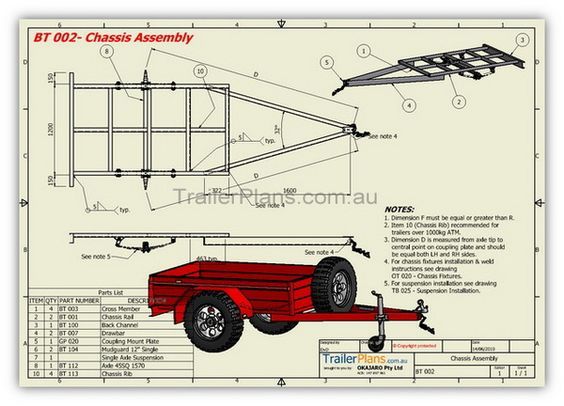 Building a utility trailer from scratch will require
Building a utility trailer from scratch will require
Following a utility trailer plan will help you gather the right components. Once you have located a source for the materials, check with the customer service representative to arrange delivery. If you are a skilled welder and have the equipment you'll need, follow the manufacturer's recommended safety and procedural instructions.
Most designs consist of a bed, a hitch, a "tongue" (the wedge shape that extends from the front), an axle with wheels, taillights, and a license plate frame.
Many of the components for utility trailers (tongue, hitch, axle, jack, and taillights) can be purchased fully assembled, making it easier to contruct.
Construct the trailer frameImage courtesy of Mechanical Elements
The frame will consist of 4 steel angle-iron rods, 2 for the sides, and 2 for the front and back.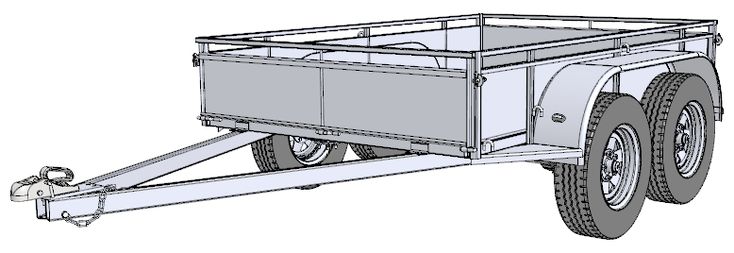 Depending on the length of the trailer, the sides will likely be longer than the front and back.
Depending on the length of the trailer, the sides will likely be longer than the front and back.
Use a hydraulic jack to raise the frame off the floor. Block all 4 corners to keep it elevated. Weld the axle under the framing. On a rectangular frame, the axle should be attached using a 60/40 ratio: 60 percent of the frame in front of the axle and 40 percent behind the axle.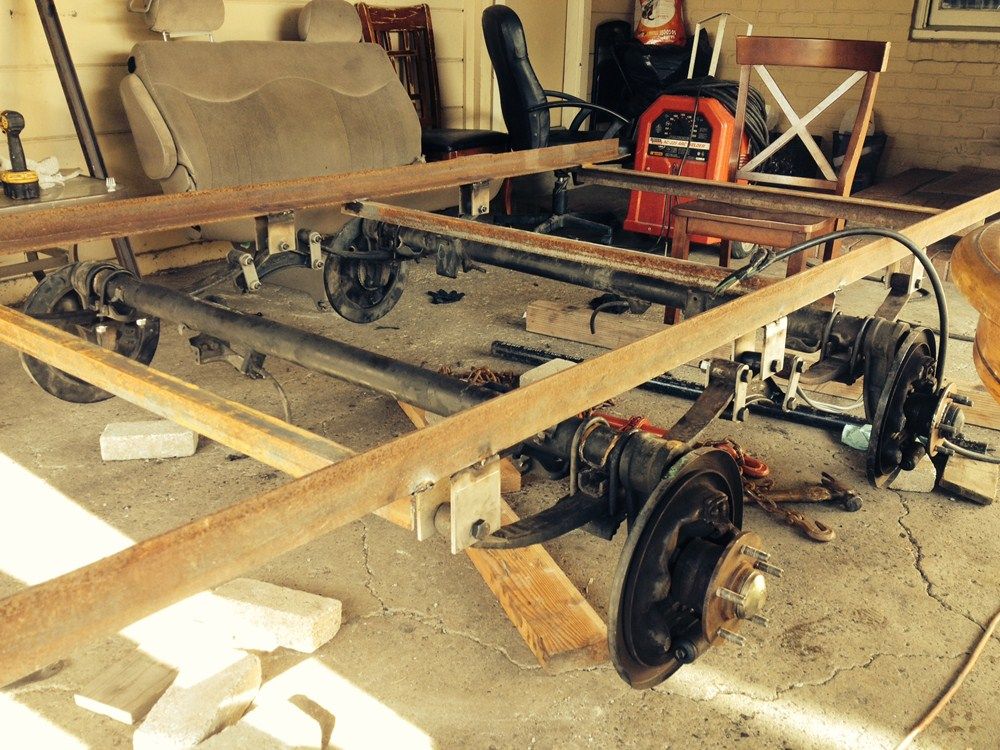
A trailer can be built with or without springs. Using a square-tube axle makes it easier to weld the axle directly to the frame. But an axle without springs produces a harsher ride.
Springs can be added to provide a softer ride for your cargo, but the center line of the axle should still remain in the same location specified in the above paragraph (60/40 ratio).
Install the spring mounts to ensure that the axle is positioned in its proper location. The fixed end of the spring should be toward the front of the trailer, and the part that is allowed to move should be toward the rear of the trailer.
Using the lug bolts and nuts included with the axle kit, install the predetermined sized tires on the axle.
There is an alternative trailer suspension that will not only soften the ride of your trailer, but give you better control – all without an axle! It’s called the Timbren Axle-Less suspension.
If you wish to retrofit 1 or 2 existing axles, the Timbren Silent Ride suspension offers you a softer ride, and – if it’s a tandem setup - provides you with a suspension that is fully equalized.
After welding the hitch to the tongue, weld the entire assembly to the front of the frame, making sure it’s centered on the frame.
Attach the jack behind the hitch on the tongue. Route the electrical wires from the front to the rear for the taillights. Make sure the taillight connector is in front.
The taillight assembly will consist of a combination of park, brake, and signal lights. The wiring harness should be secured under the trailer and the lights attached to rear with bolts on either side.
For more info about Timbren’s Axle-Less suspension, watch the video below which explains how to install it.
Trailer Kits
Shop Utility Trailer Kits at Champion Trailers
Just need new springs and axles for your trailer then take a look at our undercarriage kit. This trailer kit is great if you have a trailer in good shape but want to replace springs and hubs. If you are needing to build a new trailer check out our complete utility trailer kits. The complete trailer kits includes everything you need to build your own utility trailer. The only thing you will need to decide and purchase is the metal frame material and tires. Champion Trailer's prices on trailer part kits cannot be beat.
This trailer kit is great if you have a trailer in good shape but want to replace springs and hubs. If you are needing to build a new trailer check out our complete utility trailer kits. The complete trailer kits includes everything you need to build your own utility trailer. The only thing you will need to decide and purchase is the metal frame material and tires. Champion Trailer's prices on trailer part kits cannot be beat.
Typical frame widths can change depending upon the application and how the trailer is being built. The information below is intended to be used as a guideline for fabrication
Sort By: Featured ItemsNewest ItemsBest SellingA to ZZ to ABy ReviewPrice: AscendingPrice: Descending
Products Per Page: 812162040100
Columns: 1 2 3 4 6
Choose Options
Quick view
Now: $645.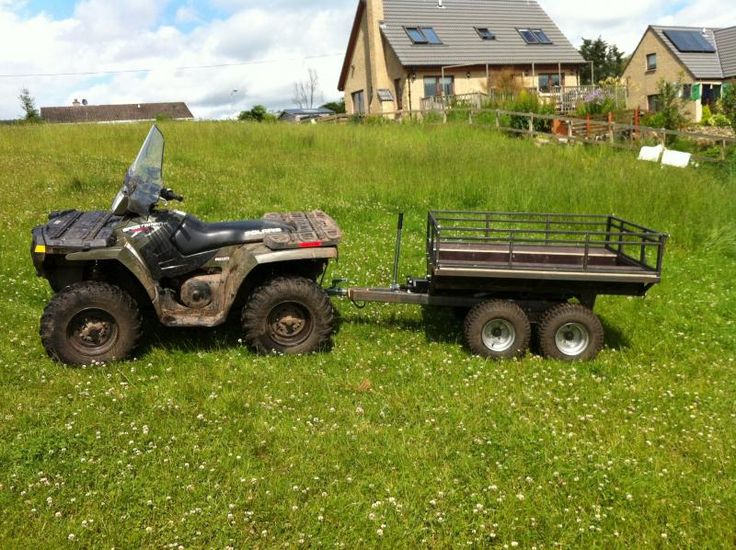 00
00
Champion's 73'' single axle utility trailer kit includes just about everything you need to get your trailer off the ground and rolling. And with our "build your own" trailer kits you can build your perfect trailer. All of the parts in our single axle...
Choose Options
Quick view
Now: $1,125.00
Champion's 85'' tandem axle utility trailer kit includes just about everything you need to get your trailer off the ground and rolling. And with our "build your own" trailer kits you can build your perfect trailer. All of the parts in our single axle...
Qty in Cart: 0
Price:
Now: $1,125.00
Subtotal:
Choose Options
Choose Options
Quick view
Now: $545.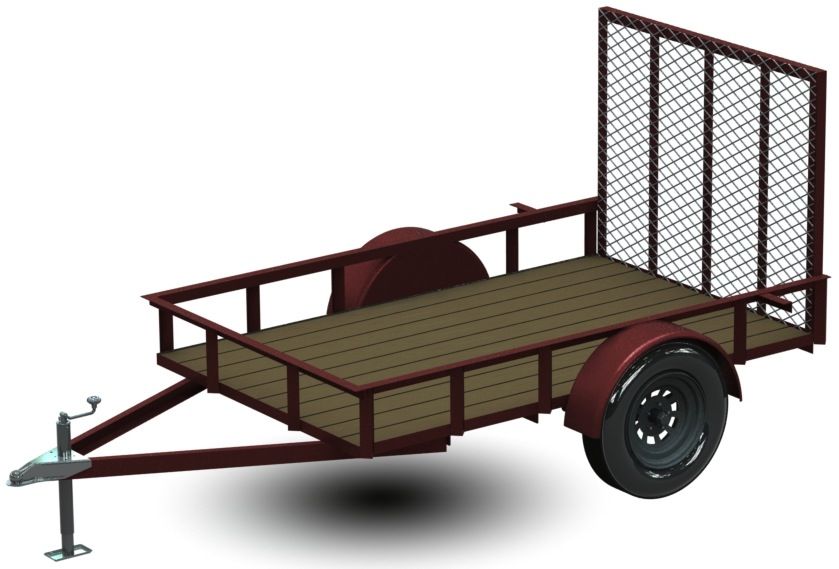 00
00
Champion's 73'' single axle utility trailer under carriage kit includes just about everything you need to get your trailer undercarriage ready to roll. And with our "build your own" trailer kits you can build your perfect trailer. All of the parts in our...
Choose Options
Quick view
Now: $690.00
Champion's 89'' single axle utility trailer kit includes just about everything you need to get your trailer off the ground and rolling. And with our "build your own" trailer kits you can build your perfect trailer. All of the parts in our single axle...
Choose Options
Quick view
Now: $1,350.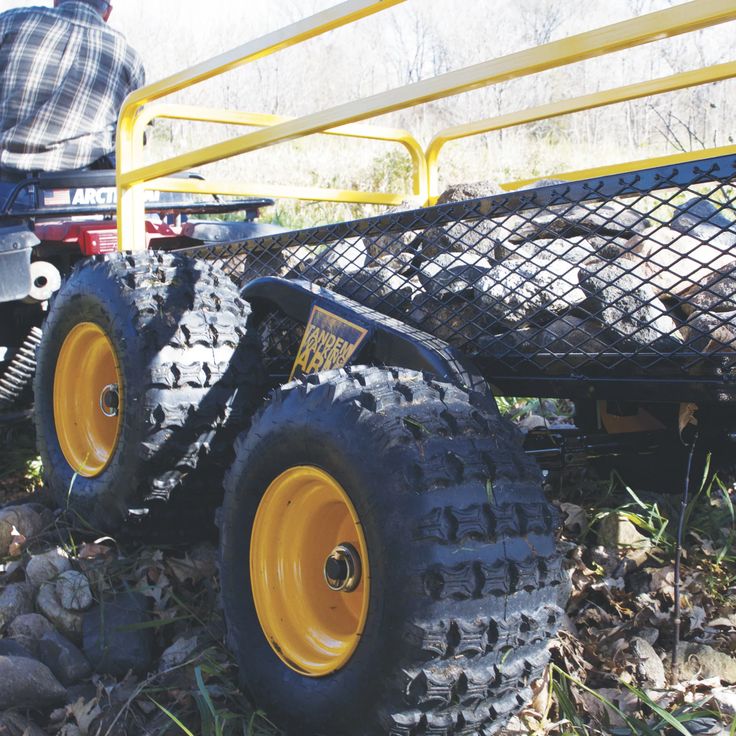 00
00
Champion's 95'' tandem axle utility trailer kit includes just about everything you need to get your trailer off the ground and rolling. And with our "build your own" trailer kits you can build your perfect trailer. All of the parts in our single axle...
Qty in Cart: 0
Price:
Now: $1,350.00
Subtotal:
Choose Options
Choose Options
Quick view
Now: $1,070.00
Champion's 89'' tandem axle utility trailer under carriage kit includes just about everything you need to get your trailer undercarriage ready to roll. And with our "build your own" trailer kits you can build your perfect trailer. All of the parts in our...
Qty in Cart: 0
Price:
Now: $1,070.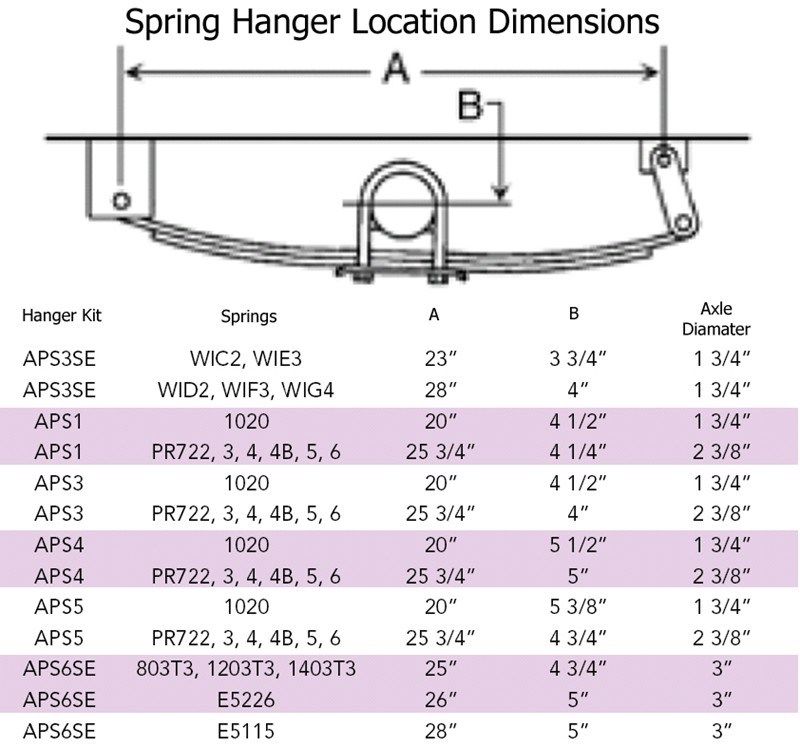 00
00
Subtotal:
Choose Options
Choose Options
Quick view
Now: $1,115.00
Champion's 73'' tandem axle utility trailer kit includes just about everything you need to get your trailer off the ground and rolling. And with our "build your own" trailer kit you can build your perfect trailer. All of the parts in our single axle...
Qty in Cart: 0
Price:
Now: $1,115.00
Subtotal:
Choose Options
Choose Options
Quick view
Now: $820.00
Champion's 95'' single axle utility trailer kit includes just about everything you need to get your trailer off the ground and rolling. And with our "build your own" trailer kits you can build your perfect trailer. All of the parts in our single axle...
And with our "build your own" trailer kits you can build your perfect trailer. All of the parts in our single axle...
Choose Options
Quick view
Now: $1,040.00
Champion's 73'' tandem axle utility trailer under carriage kit includes just about everything you need to get your trailer undercarriage ready to roll. And with our "build your own" trailer kits you can build your perfect trailer. All of the parts in...
Qty in Cart: 0
Price:
Now: $1,040.00
Subtotal:
Choose Options
Choose Options
Quick view
Now: $555. 00
00
Champion's 89'' single axle utility trailer under carriage kit includes just about everything you need to get your trailer undercarriage ready to roll. And with our "build your own" kits you can build your perfect trailer. All of the parts in our single...
Choose Options
Quick view
Now: $1,275.00
Champion's 95'' tandem axle utility trailer under carriage kit includes just about everything you need to get your trailer undercarriage ready to roll. And with our "build your own" trailer kits you can build your perfect trailer. All of the parts in our...
Qty in Cart: 0
Price:
Now: $1,275.00
Subtotal:
Choose Options
Choose Options
Quick view
Now: $685. 00
00
Champion's 85'' single axle utility trailer kit includes just about everything you need to get your trailer off the ground and rolling. And with our "build your own" trailer kits you can build your perfect trailer. All of the parts in our single axle...
View Cart Continue Shopping
Welcome to Champion Trailer Parts and Repair
Champion Trailers® is the one stop trailer shop for all your trailer parts needs and we are here to help keep your trailer rolling! Champion Trailers provides parts, service, and new trailer sales our local customers in Southeast Louisiana (Slidell, Covington, Mandeville, New Orleans) and the entire Mississippi Gulf Coast.Champion Trailers carries parts for many different brands of trailers such as Loadmaster, Starline, Magic Tilt, Magic Trail, EZ Loader, Champion, Ranger, Tracker, Venture, Float On, Big Tex, Carry On, Amera Trail, Dilly, PJ Trailers, Shoreline, and many more!Champion Trailers is the leader in Southeast Louisiana and the Mississippi Gulf Coast for boat or utility trailer repair.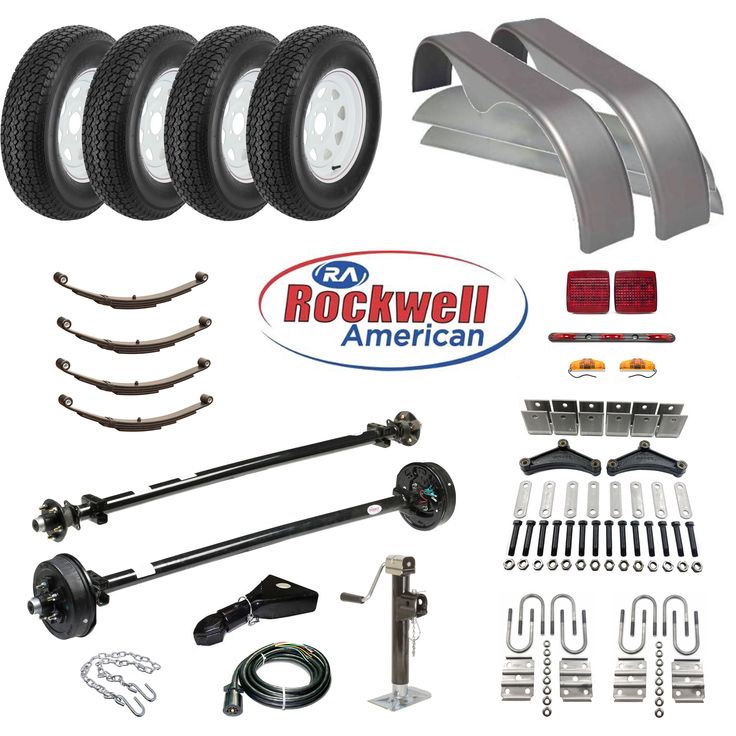 Champion Trailers can provide yearly maintenance, modifications, and repair on most boat and utility trailers such as brake install, bunk support install, axle and suspensions, lights, electric brakes, and much more! A FREE repair estimate is part of our customer service and our goal of keeping YOUR trailer rolling..
Champion Trailers can provide yearly maintenance, modifications, and repair on most boat and utility trailers such as brake install, bunk support install, axle and suspensions, lights, electric brakes, and much more! A FREE repair estimate is part of our customer service and our goal of keeping YOUR trailer rolling..
· Subscribers 0 · Very good
Rating
4.03
Storage and transportation of food, equipment and consumption materials for public catering